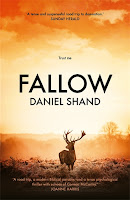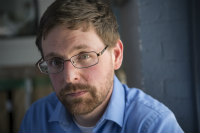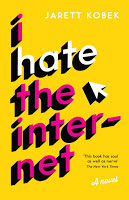In the July edition of the North Melbourne Books newsletter we talk to novelist and poet Robyn Cadwallader.
To view the latest edition of the North Melbourne Books newsletter, click
here. To sign up for our monthly newsletter, click
here.
North Melbourne Books talks to Robyn Cadwallader
London, 1321. A group of manuscript illuminators are working in a small stationer’s shop in Paternoster Row to complete a commission for a noblewoman, Mathilda. It is to be a prayer book, called a Book of Hours. John Dancaster, the master limner, is struggling to produce his best work, while the two apprentices Nick (John’s son) and Will, a haunted man with a past, all have problems of their own which threaten the completion of the manuscript. John’s wife, Gemma, a formidable intellect and talent in her own right, must hide her own considerable input into the creation of the manuscript.
What inspired you to write this story?The initial inspiration for
Book of Colours was curiosity and a question. I’ve been studying medieval literature for many years, and I’ve often come across beautifully decorated manuscripts, especially books of hours, prayer books made for the devotions of noble women. They are beautiful: all written on parchment, prayers copied carefully, and decorated by hand: a finely decorated capital or a larger picture, illuminated with gold leaf, of Christ, Mary or the saints, and some delicate foliage in the borders.
But it was the surprise of seeing thirteenth- and fourteenth-century manuscripts with a carnival of life in the margins that really had me intrigued: jugglers, dancers, cock fights, ball games; animal fables, where animals apparently wreak revenge on humans (Monty Python’s killer rabbit comes straight from a medieval manuscript!); dragons and all manner of fantastical beasts, and even scenes of sin, like a monk and a nun having sex.
All of this in a beautiful and expensive prayer book intended for a woman! How could this be? What was the purpose of such play and fantasy? Scholars have theories, but no one knows for sure. The margins seemed to resist the authority of the centre, to say that there is more to devotion than paintings of holy figures. I love those fault lines, the places where expectations are undermined, forcing us to rethink our assumptions. What rich material to explore!
Book of Colours is richly imagined, everything from the sensuous descriptions of manuscript making to the turbulent politics of the time. How did you go about researching the book?First of all, I was fortunate to have visited London and Cambridge. London has obviously grown enormously, and most of the original buildings are gone. But with my map of fourteenth-century London in my hand, I walked the streets — Cheapside, Old Change and Paternoster Row, and tried to imagine what it would have been like. Even when the city has changed, there’s something about the feeling of old streets and lanes, and especially the churches, of course, that give a sense of age sunken into the stones.
Beyond that, it was reading, reading, reading. And my imagination. I read about drainage, public hygiene, hospitals, health, markets, by-laws about privies, court rolls describing crimes, the penalties for fraudulent trading, brothels, prostitution, ale-making …. on and on. But the details about the book trade are fairly sparse, so I had to infer from the little I did know. I had to read enough to find my framework and then imagine inside that. In the end, it was me and my imagination. We’ll never know exactly what Paternoster Row looked like, but I know what my Paternoster Row and the Dancaster atelier are like.
For the illuminations themselves, I was incredibly fortunate to hold and turn the pages of some of the original fourteenth-century manuscripts in the Manuscripts Room of the British Library. I watched artists paint delicate and ornate capitals and gild the page, and I tried my hand with a quill. I read all about the various kinds of pigments and their preparation in the medieval world; the program of decoration, and the reasons why particular illuminations were included in books for women. But finally, once I had all that information, I imagined the sensuous relationship each of my limners had with the page and the paint at their desk.
Your novel has a lot of feminist themes. The reader can’t help but feel deeply for Gemma, the wife of the master limner, John Dancaster. She’s a great creative force, but must keep up appearances as a devout medieval wife. What did you hope to show with your portrayal ofGemma and her struggles? History is, as they say, written by the winners, so our information about the lives and experiences of women is limited — although there is now, fortunately, a strong wave of scholarly research on women in the Middle Ages. I’m intrigued by the ways ordinary women encountered and perhaps challenged the patriarchal structures of the medieval world. What happened when a woman’s own desires, interests and talents would not be accepted or enabled by social structures?
I would like to give such women a voice and, as far as possible, to honour their experience. My starting point in writing fiction set in the Middle Ages is to be as authentic to the period as I can be; I do not want to exploit women of the past in order to tell a story the way I would like it to be. It is clear from research that women involved in crafts worked alongside men, usually a family member such as husband or father, but were unable to become full members of craft guilds, organisations similar to our unions. So, many of them would have straddled the world of home and work, and possessed many of the same skills as men, but without the power to influence their work situation.
My interest in portraying Gemma is to explore that territory, and to do so in a way that is true to the period, inferring from thorough research. I imagine many women were simply frustrated and many others were never able to find their way beyond the everyday struggle for survival to even contemplate exploring their own talent. Perhaps some challenged social structures head-on, but I think it is more likely (and a more interesting area to explore in a novel) that women, like Gemma, sought to explore their own abilities within the limitations of their situation, nudging the limits where possible.
I’ve also sought to make Gemma a whole character, with strengths and limitations —more than simply a cipher for the lack of recognition of women. As I began writing, Gemma’s voice arose quite quickly as someone with energy and intelligence, shot through with anger. Her frustration at having her skills unrecognised has an effect on her behavior toward those around her, and she learns a bitter lesson about the need to separate her own needs from those of her children, her daughter especially. Her struggles feel very human to me. As the novel continues, it is apparent that the impact of patriarchy is not only felt by women, but will impact her husband and the family business.
The novel has a rather complicated structure, as it moves back and forth between two time periods in the 1320s. What was the writing process like? Was there a lot of planning? I don’t plan my novels, so there is a lot of editing and adjusting after the first draft! Nonetheless, I was clear from the outset that I wanted to show the ways that the book could create a kind of ‘conversation’ between the illuminators and the book’s patron, even though they would most likely never meet. The pictures are the meeting point for both creator and reader, and show up their similarities and their differences.
Mathilda, the book’s patron, and Gemma, one of the illuminators, are from quite distinct classes and I was interested in the ways in which their experiences were different, and yet, as women in a patriarchal world, also very alike. In terms of the creation of the decorated book, I wanted to explore the idea that, no matter how authoritative a text (both word and image) might be, especially a religious one, the writer and artist cannot control the way a reader will understand their work. Thus, even though the illuminators are instructed to paint according to strict conventions, Mathilda, understands and interprets each picture both according to what she has been taught, but more importantly, thorough her own needs and concerns at the time. In a similar way, as the illuminators paint, each image has the potential to stir memories and concerns, and these will be reflected in the details of the pictures they create.
So I did have a general structure in mind where Mathilda’s experience of reading the book, page by page, would be woven through the main narrative of the book’s creation, and the two timelines would dovetail toward the end. It was, of course, easier in theory than in practice, and I needed to rethink and reorganise many chapters.
I used the pictures in the book as ‘touchstones’, the points where the two timelines would meet. I especially enjoyed writing these parts of the novel — the scenes where an illuminator would paint a picture, and I could explore their feelings and memories, but in the next chapter or so, describe Mathilda viewing the very same picture with different, or perhaps similar thoughts and feelings.
The hardest aspect was that the timelines move at a different pace, but both needed to maintain forward movement. This theme is a reminder that once a work of art is made and sent into the world, the creator has no control over the ways it will be received — salutary for a novelist, but very true, I think.
And I can’t finish without a word of praise for Scrivener, a word-processing program for writers. It was a huge help, enabling me to see the big picture of the whole novel, and its various chapters and their dates, in outline, and then to shift around scenes or even paragraphs.
What books are you enjoying reading at the moment?I have just finished Jenny Ackland’s
Little Gods and enjoyed it immensely. Jenny has such a talent for dialogue and for noticing the fine, incidental details that make up so much of our lives. So often I felt myself in a lounge room, or in a garden, standing among the characters.
I’ve just begun George Saunders’
Lincoln in the Bardo and, even though I’ve read that it’s difficult, I feel completely absorbed in its world. What extraordinary imagination. It encourages me to take more risks in my writing!
And even though I normally don’t read more than one novel at a time, I’m also reading
The Last Days of Jeanne d’Arc by Ali Alizedah because I’ve been asked to review it. I do like its shifting narratives and various voices, though I find the details of battles and military negotiations less interesting than Jeanne herself.
Book of Colours, by Robyn Cadwallader. Published by HarperCollins. $32.99






















